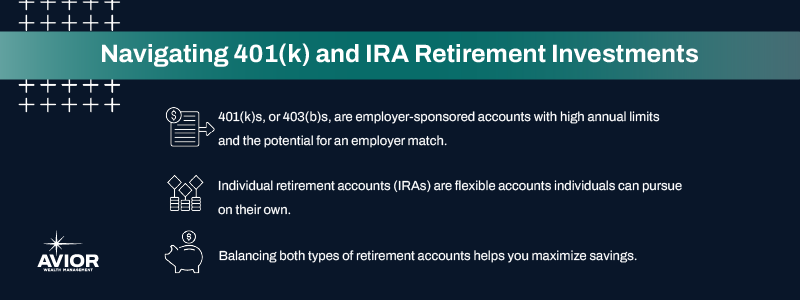Navigating 401(k) and IRA Retirement Investments
401(k)s and IRAs are common accounts to save for retirement. Find out how to optimize tax planning and maximize investments.

Your financial goals may change over time, but you need a plan to ensure you’ll have enough income to meet your retirement goals.
Retirement planning is a critical aspect of financial stability, and the two most common accounts are 401(k) and individual retirement accounts (IRAs). These investment vehicles help you build a secure financial future, yet you may not understand all the intricacies surrounding contributions, rules, and tax implications.
This article demystifies the complexities surrounding 401(k) vs. IRA savings and contributions, giving you a comprehensive understanding to empower your retirement journey.
401(k) basics
401(k) plans are employer-sponsored retirement savings accounts. Note that 403(b) plans work the same way as 401(k)s but are provided to public schools and certain nonprofit employees.
Typically, employees can contribute a set amount of their salary to a 401(k), and employers may match a percentage of this contribution. This not only accelerates the growth of the retirement fund but also serves as a valuable employee benefit. For 2023, the contribution limit is $22,500, but if you’re over 50, you can add an additional $7,500. And if you’re between 60 and 63, you can add $10,000.
Both Traditional and Roth 401(k) plans offer distinct tax advantages, but they differ in how and when these benefits are applied. Understanding these differences can help you decide which type of 401(k) is best suited to your financial situation and retirement goals.
Traditional 401(k)
- Pre-tax contributions: Contributions to a Traditional 401(k) are made with pre-tax dollars. This reduces your taxable income in the year you contribute, potentially lowering your current tax bill.
- Tax-deferred growth: Your Traditional 401(k) investments grow tax-deferred. This means you don’t pay taxes on capital gains, dividends, or interest within the account as they accrue.
- Taxed upon withdrawal: The money you withdraw from a Traditional 401(k) during retirement is taxed as ordinary income. This could be advantageous if you’re in a lower retirement tax bracket than when working.
- Reduced Adjusted Gross Income (AGI): Since pre-tax contributions lower your AGI, it can have other tax benefits like qualifying for additional deductions and credits.
- Potential for immediate tax savings: The immediate tax relief from pre-tax contributions can be beneficial if you’re currently in a high tax bracket and expect to be in a lower one in retirement.
Roth 401(k)
- After-Tax Contributions: Contributions to a Roth 401(k) are made with after-tax dollars. There’s no upfront tax deduction, meaning no immediate tax benefit in the contribution year.
- Tax-free withdrawals: Withdrawals of contributions and earnings are tax-free in retirement, assuming you are 59½ years old and have held the account for at least five years. This is particularly advantageous if you expect to be in a higher tax bracket in retirement.
- No tax on investment growth: The investment earnings in a Roth 401(k) grow tax-free, which can be significant over a long compounding period.
- No required minimum distributions (RMDs): If you roll over your Roth 401(k) into a Roth IRA, you can avoid RMDs. This is not the case with a Traditional 401(k), which requires RMDs starting at age 72.
- Better tax diversification in retirement: Having funds in a Roth 401(k) provides more flexibility in managing your taxable income in retirement, as you can choose to withdraw from your Roth account in years when doing so would be more tax-efficient.
The choice between a Traditional and Roth 401(k) often hinges on your current tax situation versus what you anticipate it will be in retirement. If you expect your retirement tax rate to be higher, a Roth 401(k) might be more beneficial due to its tax-free withdrawals. On the other hand, if you expect a lower tax rate in retirement, a Traditional 401(k) could be more advantageous because of the immediate tax deduction and deferred taxation.
IRA basics
IRAs are available outside your employer, so you can save more for retirement. Limits for 2023 are $6,500 for the year, but if you’re over 50, you can add $1,000. IRAs come in various forms, including traditional and Roth. This section will outline their unique features and suitability for different individuals:
Traditional IRAs
- Pre-tax contributions: Contributions are typically tax-deductible, offering an immediate reduction in taxable income.
- Tax-deferred growth: Earnings grow tax-deferred until withdrawal during retirement.
- Taxes upon withdrawal: Withdrawals are taxed like ordinary income.
- Required minimum distributions (RMDs): Mandatory withdrawals must begin at age 72.
Roth IRAs
- After-tax contributions: Contributions are made with after-tax dollars, but withdrawals in retirement are tax-free.
- Tax-free withdrawals: Earnings grow tax-free, and there are no mandatory withdrawals.
- No RMD: No RMDs during the account holder’s lifetime
- Income limits: Contribution limits based on income level.
Choosing between these options depends on individual circumstances, including current and future tax situations. If you expect to be in a lower tax bracket in retirement, a Traditional IRA might be more beneficial because of the immediate tax break on contributions. However, if you anticipate being in a higher tax bracket in retirement, a Roth IRA could be more advantageous because of the tax-free withdrawals.
There are also SIMPLE IRAs, which are geared toward small businesses with fewer than 100 employees, and SEP IRAs, which can be used by small business owners and self-employed individuals.
Strategies for optimizing 401(k) and IRA contributions
It’s possible to be strategic and optimize contributions to both 401(k) and IRAs, helping you ensure long-term success. These actionable strategies empower you to maximize the potential of these investment vehicles:
1. Maximizing your contributions
One fundamental strategy involves maximizing contributions to 401(k) and IRA accounts each year. Capitalizing on the allowed contribution limits, you can boost retirement savings.
2. Balancing Traditional and Roth contributions
Traditional 401(k) and IRA contributions offer immediate tax benefits, reducing taxable income. In contrast, Roth contributions provide tax-free withdrawals in retirement. Balancing these contributions helps you manage your tax liability effectively, considering both current and future financial situations.
3. Utilizing employer match programs
For individuals with employer-sponsored 401(k) plans offering matching contributions, taking full advantage of these programs is a powerful optimization strategy. Employer matches represent free money, significantly boosting the overall growth of the retirement fund. Contribute at least enough to capture the full employer match to maximize benefits.
4. Rebalancing and diversifying investments
Regularly reviewing and rebalancing investment portfolios within 401(k)s and IRAs is crucial for optimizing returns while managing risk. Diversification across asset classes helps spread risk and can enhance overall portfolio performance. Adjusting allocations based on market conditions and individual risk tolerance ensures that the investment strategy aligns with evolving financial goals.
5. Navigating rules and regulations
Understanding the rules governing withdrawals, loans from 401(k)s, and IRA rollovers is crucial to avoiding penalties and optimizing retirement savings. Pay attention to these rules, and discuss your options and plans with a financial advisor for expert guidance.
6. Planning beyond your 401(k) and IRA
While 401(k) and IRA contributions are integral to retirement planning, remember to adopt a holistic approach. Explore other investment options and savings strategies, like setting up other investment accounts in the stock market or investing in the real estate market. Your 401(k) and IRA investments are part of your broader retirement plan that aligns with your long-term financial goals.
Empowering your retirement journey with the right plans
Understanding 401(k) and IRA contributions and tax advantages helps you create your retirement plan for a better future. By addressing common challenges and taking the right steps, you can make informed decisions to maximize your retirement potential and ensure financial security.
Working with a financial expert is key so you know the best strategies for you and your family and how to meet your retirement planning goals. The team at Avior is ready to guide you along the way. We focus on wealth management strategies that help you invest wisely, protect your assets, and optimize your tax strategy.
Get in touch with Avior today to get started.
Disclaimer: Nothing contained herein should be construed as legal or tax advice. Avior and our Advisors will work with your attorney and/or tax professional to assist with your legal and tax strategies. Please consult your attorney or tax professional with specific legal and/or tax questions.
No Comments
Sorry, the comment form is closed at this time.




